Australia is brimming with a variety of unique and beautiful flora and fauna, and among its botanical wonders, the native flowering plants stand out as vibrant symbols of the continent’s natural richness. In this exploration, we’ll look into the 11 best Australian native flowering plants. From the iconic Billy Buttons to the delicate Kangaroo Paw, each of these flower plants not only adds a burst of color to the diverse landscapes but also carries deep cultural significance. Come along as we explore 11 native Australian flowering plants, creating a handy guide for gardening enthusiasts and flower lovers. In this blog, we will look at the fascinating history, meanings, and relationships behind these remarkable flowering plants, providing insights for those who want to include native flora in their gardens.
1. Billy Buttons

Billy Buttons is a native Australian flowering plant that is known for its amusing and uncommon appearance. These blooms, with golden globes like bright pom-poms on slender stalks, give a touch of whimsy to gardens across the country. Billy Buttons have cultural importance in addition to their visual appeal, representing enthusiasm, positivism, and endurance. They flourish in a variety of climates as low-maintenance and adaptable perennials, demonstrating persistence and making them a popular choice for your gardening projects.
Known scientifically as Craspedia, these flowers belong to the Asteraceae family, highlighting the rich biodiversity of Australia. Their ability to adapt and thrive in various conditions makes Billy Buttons a resilient and enduring choice for gardeners. Bursting into golden spheres from late spring to early summer, these blooms create a vibrant contrast against the green backdrop, bringing a burst of color and enduring charm to gardens. Whether you’re a gardening enthusiast or simply looking to add a touch of joy to outdoor spaces, the whimsical Billy Buttons are sure to make a delightful addition to your garden.
Scientific Name- Craspedia globosa
Flowering Season- Spring, Summer
2. Waratah
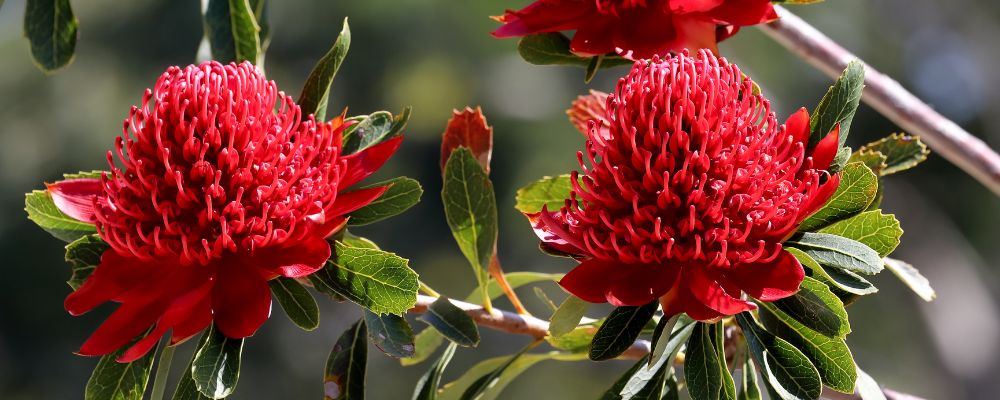
The waratah is a flower that has been proudly chosen as the state floral emblem of New South Wales, and its beauty is unmistakable. Characterized by vibrant redheads that reveal themselves as clusters of tightly packed small red flowers upon closer inspection, each floral head spans an impressive 6-15 cm in diameter, creating a visually striking and iconic display. Florists are enchanted by the waratah’s unique charm and often choose to include these blooms in wedding bouquets or cut flower arrangements.
The peculiar shape and striking color of the waratah add a touch of individuality to floral designs, making it a favored choice for those seeking both elegance and a bold burst of color in their arrangements. As a symbol of New South Wales’ natural heritage, the waratah not only graces the landscape but also finds its way into the hearts of those who appreciate its distinctive and captivating allure. The waratah’s cultural significance and ecological importance make it a true icon of Australian native flowering plants.
Scientific Name- Telopea speciosissima
Flowering Season- Spring
3. Kangaroo Paw
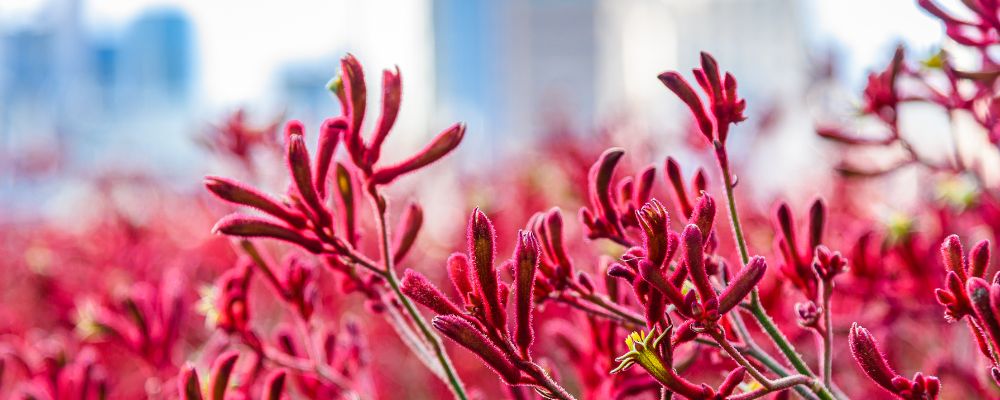
Are you looking for a unique way to add vibrancy to your garden? Look no further than the Kangaroo Paw, an Australian native flowering plant that captivates with its intricate tubular flowers and vibrant colors. Scientifically known as Anigozanthos, this plant derives its name from the paw-like shape of its blooms, which also serves as a landing platform for pollinating birds. Native to the southwestern parts of Australia, the Kangaroo Paw blooms in vibrant red, yellow, and green hues, each carrying unique significance. Red symbolizes energy, green represents the environment, and yellow signifies happiness and positivity, adding a colorful dimension to gardens.
Pro Tip:
Indulge in Australia's iconic foods. Explore the unique flavors for an authentic Aussie culinary experience!
Deeply intertwined with Aboriginal culture, the Kangaroo Paw is associated with the animal it’s named after, symbolizing unity and strength. Flourishing as a robust perennial in well-drained soils, it not only adds a touch of Australian wilderness to gardens worldwide but also brings cultural connections to the botanical landscape. Celebrate the diverse and resilient spirit of this extraordinary native plant and its rich cultural ties.
Scientific Name- Anigozanthos
Flowering Season- Spring to Summer
4. Sturt's Desert Pea

Sturt’s Desert Pea is a well-known native floral plant that can withstand the severe desert climate. Scientifically known as Swainsona formosa, this plant features deep red, almost black, pea-like flowers contrasted against silvery-green foliage. Beyond its attractive appearance, Sturt’s Desert Pea holds significant cultural significance in Indigenous Australian mythology, often representing the heroic blood of Dreamtime heroes, and its vibrant blooms emerge after rainfall, transforming the desolate desert into a breathtaking display of color.
As the floral emblem of South Australia, Sturt’s Desert Pea has inspired numerous print designs, including the state’s coat of arms. You can find the striking contrast of its blood-red petals and black pea-like center gracing various items, from stationery and bookmarks to posters and tattoos. This hardy perennial represents persistence and adaptation, thriving in well-drained, sandy soils and thus making a good choice for your gardens. So, to make your yard look alive and lovely, consider introducing this distinctive Australian native flower to your garden.
Scientific Name- Swainsona formosa
Flowering Season- Spring to Summer
5. Banksia
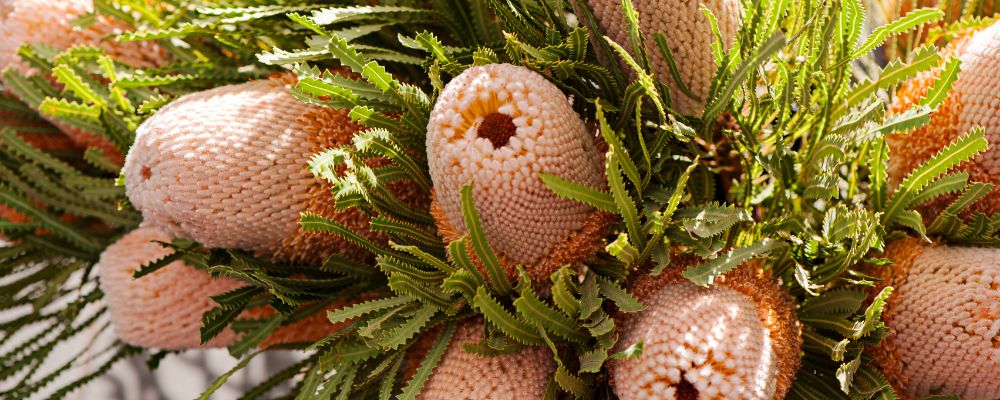
Explore the beautiful world of Banksia, a diverse group of Australian native flowering plants that exhibit a stunning array of shapes, sizes, and textures. With more than 170 species, Banksias are renowned for their unique cylindrical flower spikes, which often resemble brushes or cones. These plants belong to the Proteaceae family and are distributed across a wide range of ecosystems, from coastal heathlands to arid inland regions. Banksias play a significant ecological role by providing nectar-rich flowers that attract a variety of native birds, insects, and mammals. Moreover, the cones serve as an important food source for wildlife, highlighting the interdependence of Australia’s flora and fauna.
Beyond their ecological significance, Banksias also have cultural importance, with Indigenous Australians utilizing different parts of the plant for various purposes, from tool-making to traditional medicine. With a vast range of species, each with its own unique features, Banksias offers a versatile choice for gardens, adding texture, color, and a touch of Australian wilderness. Whether you choose the iconic Banksia serrata or the elegant Banksia integrifolia, these plants will surely change the outlook of your garden.
Scientific Name- Banksias (multiple species)
Flowering Season- Autumn and Winters (varies depending on species)
6. Canberra Bells
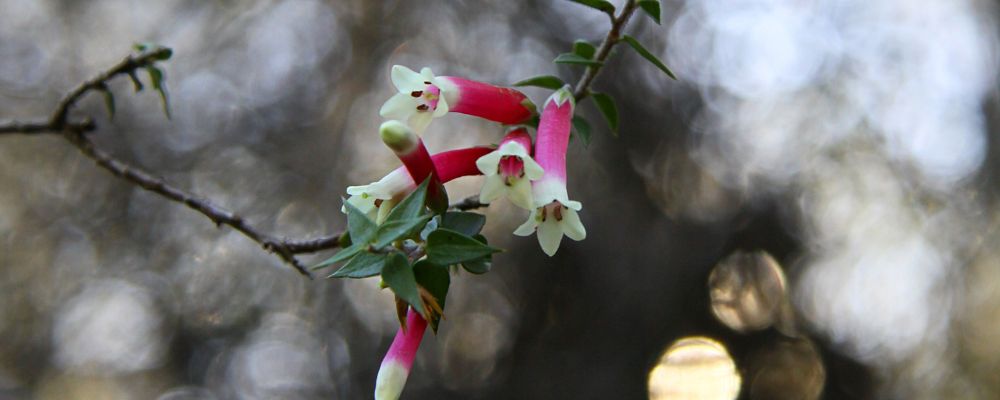
The Canberra Bells is a beautiful and delicate flowering plant that grows in woodlands and heathlands of southeastern Australia. The plant belongs to the Correa genus, which includes various species, each with its unique charm. Canberra Bells are well-known for their tubular flowers that come in a range of colors from light pink to deep red, attracting native birds and insects. The plant holds cultural significance, especially in the Australian Capital Territory, where it is recognized as the floral emblem.
Canberra Bells have the ability to grow and thrive in various environments, including coastal regions and mountainous landscapes. Thus, the plant symbolizes the resilience and adaptability required to flourish in Australia’s diverse climates. When used in gardens, Canberra Bells add a touch of elegance and native beauty. It can be used as a border plant or featured in mixed plantings, and its bell-shaped blooms evoke a sense of harmony with nature, making it a beautiful addition to your garden space.
Scientific Name- Correa (multiple species)
Flowering Season- Spring to Autumn
7. Wattles
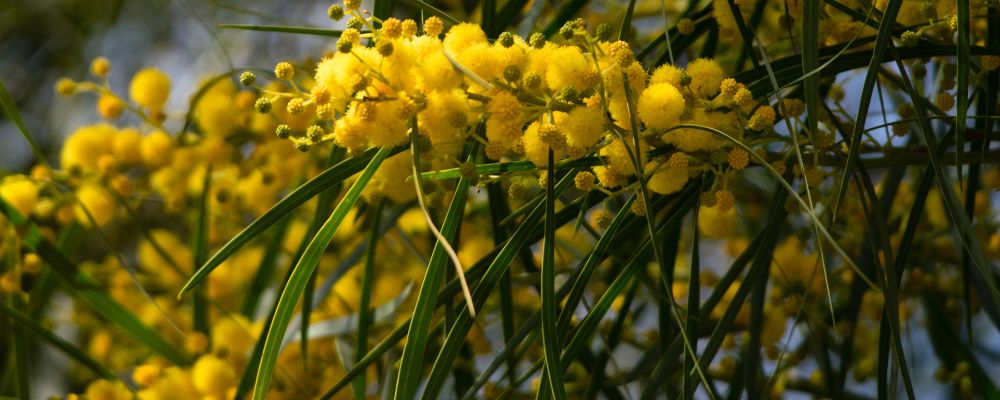
Next on our list we have Wattle, a vibrant member of the Acacia genus, and rejoice in the sheer diversity of Australia’s floral landscape. These flowering plants are known for their distinctive, golden, fluffy flower clusters that joyfully announce the arrival of spring. From rainforests to arid regions, Wattles showcase the adaptability and resilience of Australian flora, growing rapidly from seed and producing stunning yellow flowers from a young age.
Pro Tip:
Explore Australia's Best Gardens for diverse flora and captivating landscapes. Visit during peak blooming seasons for an enchanting botanical experience.
inspire Australia’s national colors, green and gold, with their cultural significance as symbols of endurance and unity. Regardless of the species you select, these low-maintenance plants will effortlessly provide a burst of color and a nod to Australia’s biodiversity in your outdoor area.
Scientific Name- Acacia (multiple species)
Flowering Season- Spring and Summer (varies depending on species)
8. Geraldton Wax
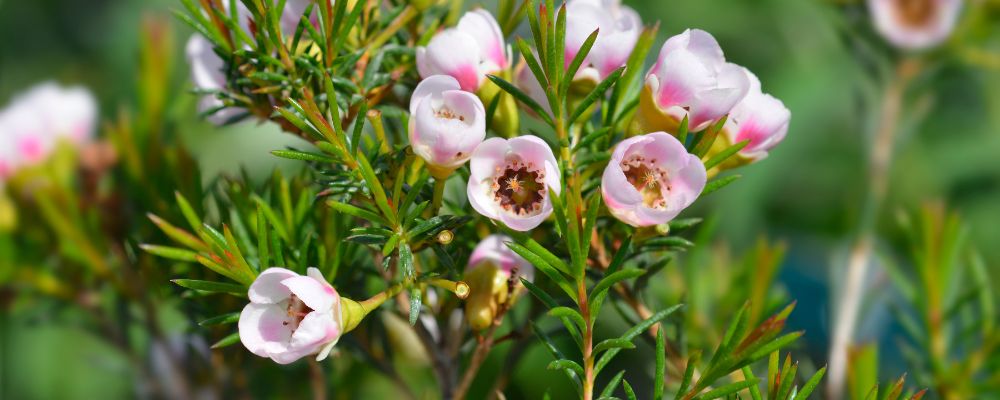
The Geraldton Wax, the most widely grown wax flower, is a favorite in native plants due to its pink blooms. It grows in full sun, well-drained soil, and moderate temperatures. This evergreen shrub is renowned for its profusion of waxy flowers, ranging in color from white and pink to deep red. The intricate, star-shaped blooms not only add visual interest but also attract native birds and insects. Geraldton Wax holds cultural significance, especially in Western Australia, where it is embraced as one of the state’s floral emblems.
This plant, which can grow in both coastal and sandy soils, represents the adaptability and persistence needed to flourish in Australia’s different environments. Geraldton wax is often used in gardens due to its versatility. Its bright flowers and fragrant leaves provide a sensory treat whether used as a hedge, potted plant, or part of mixed plantings. Through its flowers, Geraldton Wax invites you to step into the sun-kissed landscapes of Australia, embracing the beauty of the West Coast in your garden.
Scientific Name- Chamelaucium uncinatum
Flowering Season- Spring, Summer, and Winters
9. Bottlebrush
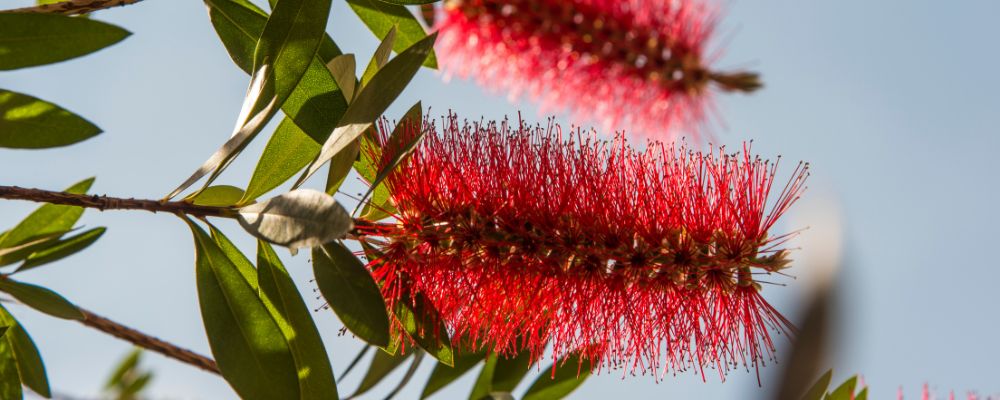
These native Australian plants resemble bottlebrush, as their name suggests. Plants with distinctive forms and vivid colors ranging from red to pink to yellow are popular among gardeners. They are most known for their cylindrical, brush-like flower spikes. In addition to being aesthetically pleasing, bottlebrushes are essential for the survival of local fauna. Honeyeaters, butterflies, and other pollinators are drawn to the nectar-rich flowers, which enhance the biodiversity of Australian gardens.
For gardening enthusiasts seeking a low-maintenance and resilient option, the bottlebrush proves to be an excellent choice. Boasting both vibrant beauty and durability, this Australian native flower is renowned for its adaptability, making it well-suited for various soil types and climates. Embracing the title of one among many Australian native flowers, particularly those with the notorious “brown thumbs,” the bottlebrush, with its charming Callistemon viminalis variety, ensures a garden adorned with gorgeous, colorful blooms. Overall, this flowering plant offers both visual appeal and simplicity for those looking to effortlessly enhance their outdoor spaces with a touch of Australia’s floral charm to their garden.
Scientific Name- Callistemon (multiple species)
Flowering Season- Spring to Summer (varies depending on species)
10. Australian Daisy
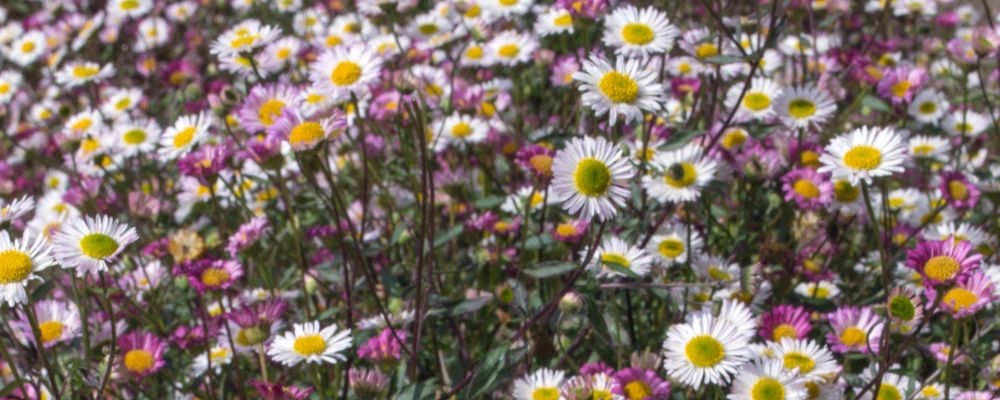
Discover the vibrant world of Australian Daisies, a varied collection of blooming plants from the genus Brachyscome and others. These daisies give Australian landscapes, from coastal regions to alpine meadows, a whimsical touch with their vivid and colorful blossoms. Australian daisies produce a wide range of colors in gardens because they come in a variety of colors, including white, pink, purple, and blue.
These delicate, daisy-like blossoms are a popular choice for formal gardens as well as wildflower fields because they represent simplicity and natural beauty. Australian Daisies are hardy perennials that work well in a variety of garden types, including rock gardens and borders. Their ability to flourish in full sun and well-drained soils makes them a hardy and low-maintenance choice for gardeners looking for a splash of color and a link to Australia’s natural flora.
Scientific Name- Brachyscome (multiple species)
Flowering Season- Spring, Autumn, Winter (varies depending on species)
11. Chorizema
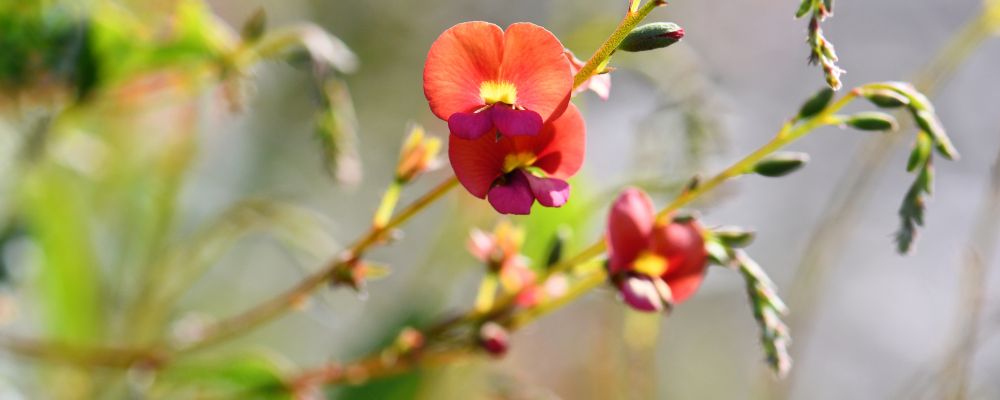
Last in our list of Australian native flowers we have Chorizema, a group of vibrant flowering plants native to Australia that brings a burst of color to the landscape. Known for their eye-catching tubular flowers in pink, orange, and red, these plants not only look stunning but also serve as a cozy spot for native birds and insects. With green foliage that varies in texture, Chorizema thrives in rocky areas, well-drained soils, and along the coast, showcasing its adaptability to Australia’s diverse environments.
Pro Tip:
Explore the joy of Australian Christmas delights with locally sourced ingredients for an authentic and festive touch.
This flower holds a special place in Indigenous Australian traditions, symbolizing resilience and adaptability. Its unique appearance and ability to grow in different places have made it part of cultural narratives. For gardeners, Chorizema is a top pick, especially for rockeries and native landscapes. Its cascading growth makes it perfect for slopes and walls, adding a touch of nature to your garden. And, it’s not just for looks; Chorizema’s appeal goes beyond aesthetics, attracting native pollinators and contributing to the biodiversity of your garden. So, whether you’re admiring its beauty or adding it to your garden, Chorizema offers a colorful link between Australia’s natural charm and cultural history.
Scientific Name- Chorizema (multiple species)
Flowering Season- Spring, Summer, and Winters
Conclusion
Australia is home to a vast array of native flowering plants, which contribute to the country’s unique and vibrant natural scenery. The above-mentioned flowering plants provide a glimpse into the diverse botanical wonders that thrive in Australia’s various climates. These plants are not only visually appealing but also play crucial roles in supporting the local ecosystems and wildlife. Recognizing the importance of these native species encourages us to value conservation efforts, ensuring the preservation of Australia’s natural heritage and ecological balance.

